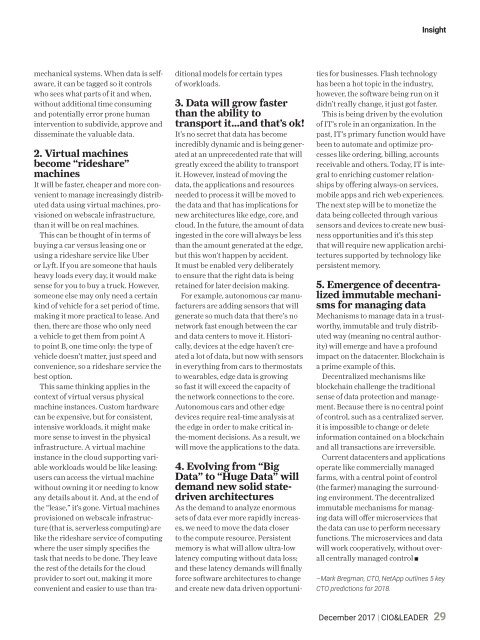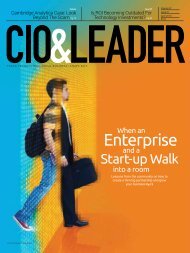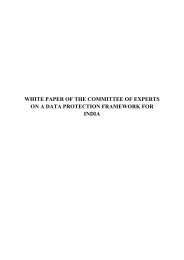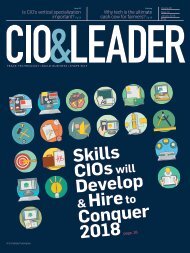C&L_December 2017 (1)
Create successful ePaper yourself
Turn your PDF publications into a flip-book with our unique Google optimized e-Paper software.
Insight<br />
mechanical systems. When data is selfaware,<br />
it can be tagged so it controls<br />
who sees what parts of it and when,<br />
without additional time consuming<br />
and potentially error prone human<br />
intervention to subdivide, approve and<br />
disseminate the valuable data.<br />
2. Virtual machines<br />
become “rideshare”<br />
machines<br />
It will be faster, cheaper and more convenient<br />
to manage increasingly distributed<br />
data using virtual machines, provisioned<br />
on webscale infrastructure,<br />
than it will be on real machines.<br />
This can be thought of in terms of<br />
buying a car versus leasing one or<br />
using a rideshare service like Uber<br />
or Lyft. If you are someone that hauls<br />
heavy loads every day, it would make<br />
sense for you to buy a truck. However,<br />
someone else may only need a certain<br />
kind of vehicle for a set period of time,<br />
making it more practical to lease. And<br />
then, there are those who only need<br />
a vehicle to get them from point A<br />
to point B, one time only: the type of<br />
vehicle doesn’t matter, just speed and<br />
convenience, so a rideshare service the<br />
best option.<br />
This same thinking applies in the<br />
context of virtual versus physical<br />
machine instances. Custom hardware<br />
can be expensive, but for consistent,<br />
intensive workloads, it might make<br />
more sense to invest in the physical<br />
infrastructure. A virtual machine<br />
instance in the cloud supporting variable<br />
workloads would be like leasing:<br />
users can access the virtual machine<br />
without owning it or needing to know<br />
any details about it. And, at the end of<br />
the “lease,” it’s gone. Virtual machines<br />
provisioned on webscale infrastructure<br />
(that is, serverless computing) are<br />
like the rideshare service of computing<br />
where the user simply specifies the<br />
task that needs to be done. They leave<br />
the rest of the details for the cloud<br />
provider to sort out, making it more<br />
convenient and easier to use than traditional<br />
models for certain types<br />
of workloads.<br />
3. Data will grow faster<br />
than the ability to<br />
transport it...and that’s ok!<br />
It’s no secret that data has become<br />
incredibly dynamic and is being generated<br />
at an unprecedented rate that will<br />
greatly exceed the ability to transport<br />
it. However, instead of moving the<br />
data, the applications and resources<br />
needed to process it will be moved to<br />
the data and that has implications for<br />
new architectures like edge, core, and<br />
cloud. In the future, the amount of data<br />
ingested in the core will always be less<br />
than the amount generated at the edge,<br />
but this won’t happen by accident.<br />
It must be enabled very deliberately<br />
to ensure that the right data is being<br />
retained for later decision making.<br />
For ex<strong>amp</strong>le, autonomous car manufacturers<br />
are adding sensors that will<br />
generate so much data that there's no<br />
network fast enough between the car<br />
and data centers to move it. Historically,<br />
devices at the edge haven’t created<br />
a lot of data, but now with sensors<br />
in everything from cars to thermostats<br />
to wearables, edge data is growing<br />
so fast it will exceed the capacity of<br />
the network connections to the core.<br />
Autonomous cars and other edge<br />
devices require real-time analysis at<br />
the edge in order to make critical inthe-moment<br />
decisions. As a result, we<br />
will move the applications to the data.<br />
4. Evolving from “Big<br />
Data” to “Huge Data” will<br />
demand new solid statedriven<br />
architectures<br />
As the demand to analyze enormous<br />
sets of data ever more rapidly increases,<br />
we need to move the data closer<br />
to the compute resource. Persistent<br />
memory is what will allow ultra-low<br />
latency computing without data loss;<br />
and these latency demands will finally<br />
force software architectures to change<br />
and create new data driven opportunities<br />
for businesses. Flash technology<br />
has been a hot topic in the industry,<br />
however, the software being run on it<br />
didn’t really change, it just got faster.<br />
This is being driven by the evolution<br />
of IT’s role in an organization. In the<br />
past, IT’s primary function would have<br />
been to automate and optimize processes<br />
like ordering, billing, accounts<br />
receivable and others. Today, IT is integral<br />
to enriching customer relationships<br />
by offering always-on services,<br />
mobile apps and rich web experiences.<br />
The next step will be to monetize the<br />
data being collected through various<br />
sensors and devices to create new business<br />
opportunities and it’s this step<br />
that will require new application architectures<br />
supported by technology like<br />
persistent memory.<br />
5. Emergence of decentralized<br />
immutable mechanisms<br />
for managing data<br />
Mechanisms to manage data in a trustworthy,<br />
immutable and truly distributed<br />
way (meaning no central authority)<br />
will emerge and have a profound<br />
impact on the datacenter. Blockchain is<br />
a prime ex<strong>amp</strong>le of this.<br />
Decentralized mechanisms like<br />
blockchain challenge the traditional<br />
sense of data protection and management.<br />
Because there is no central point<br />
of control, such as a centralized server,<br />
it is impossible to change or delete<br />
information contained on a blockchain<br />
and all transactions are irreversible.<br />
Current datacenters and applications<br />
operate like commercially managed<br />
farms, with a central point of control<br />
(the farmer) managing the surrounding<br />
environment. The decentralized<br />
immutable mechanisms for managing<br />
data will offer microservices that<br />
the data can use to perform necessary<br />
functions. The microservices and data<br />
will work cooperatively, without overall<br />
centrally managed control<br />
–Mark Bregman, CTO, NetApp outlines 5 key<br />
CTO predictions for 2018.<br />
<strong>December</strong> <strong>2017</strong> | CIO&LEADER<br />
29














